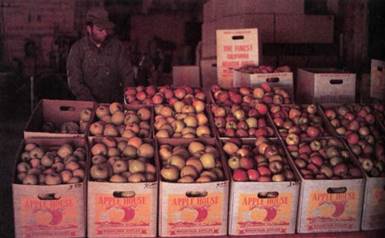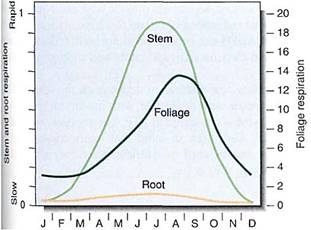
Environmental and Internal Factors
 المؤلف:
AN INTRODUCTION TO PLANT BIOLOGY-1998
المؤلف:
AN INTRODUCTION TO PLANT BIOLOGY-1998
 المصدر:
JAMES D. MAUSETH
المصدر:
JAMES D. MAUSETH
 الجزء والصفحة:
الجزء والصفحة:
 2-11-2016
2-11-2016
 2719
2719
Environmental and Internal Factors
As with photosynthesis, numerous environmental factors influence the rate of respiration. It is necessary to consider the integration of respiration into the total biology of the plant as well as the metabolic pathways involved.
TEMPERATURE
Temperature greatly influences respiration in a plant growing under natural conditions. In all environments shoots located in air are at a different temperature than roots in soil. Shoots are subjected to great changes of temperature from day to night, often more than 20°C.
In most tissues, an increase in temperature of 10°C, in the range between 5 and 25°C; doubles the respiration rate, a magnitude of increase seen in many enzyme-mediated reactions. Below 5°C, respiration decreases greatly (Fig. 1). Above 30°C, respiration still increases, but not so rapidly; at such high temperatures, oxygen probably cannot diffuse into tissues as rapidly as the tissues use it. Above 40°C, respiration, like many other processes, slows greatly, probably owing to enzyme damage or disruption of organelle membranes.

FIGURE 1:Many fruits and vegetables are stored in refrigeration to reduce respiration and thus preserve starch and sugar content. (©Tom Myers)
LACK OF OXYGEN
Because plants are not as active as animals, much lower oxygen concentrations—as little as 1% to 2%—are sufficient to maintain full rates of plant respiration. Oxygen concentration in the atmosphere is so stable that it does not cause variations in respiration, but variations occur in a cell's access to oxygen. During daylight hours, chlorophyllous tissues and organs produce oxygen, some of which is used in respiration. At night oxygen is not produced, but it can diffuse into the large intercellular spaces of the plant if it can penetrate the closed stomata. Because the cuticle is not absolutely impermeable to oxygen and because the atmosphere contains such a high concentration, oxygen diffuses in rather well, even though closed stomatal pores. Less oxygen is available, but the temperature is lower and so the demand for oxygen is reduced.
Oxygen availability is much more variable for roots; in well-drained soil, the large quantity of gas located between soil particles is depleted in oxygen owing to respiration by roots, fungi, bacteria, protists, and soil animals. During and after rain, soil air is displaced by water, and roots either have lesser amounts of oxygen (hypoxia) or none (anoxia) available. Anaerobic respiration allows roots to survive for a short period, but it is not sufficient for root growth and healthy metabolism. If continually flooded, the roots of almost any species die. Those that survive do so primarily by oxygen diffusion from the stems through aerenchyma channels in the cortex or pith, such as in petioles of water lilies and cattails. Rice seedlings are the only certain example of plants that can grow normally without oxygen for a prolonged period.
In thick tubers (potatoes) or bulky roots (beets, carrots), it is not well established whether respiration is completely aerobic or at least partially anaerobic. Such organs usually have a significant amount of intercellular space through which oxygen might diffuse, but the concentration of oxygen is very low. Similarly, the sapwood and cambium of trees with thick bark may be hypoxic; even though lenticels are present, the diffusion path is long and the dense inner bark, cambium, and sapwood lack intercellular spaces. Developing embryos inside large seeds and fruits are reported to respire anaerobically.
INTERNAL REGULATION
Like virtually all other processes, respiration is subject to specific metabolic controls. Cells that have an active metabolism, such as glands that secrete protein or epidermal cells that secrete waxes, have a high level of aerobic respiration, whereas meristematic cells produce ribose by means of the pentose phosphate pathway. Nearby cells, perhaps those of the spongy mesophyll or collenchyma, may have a much lower respiration rate (Fig. 2). During fruit maturation, respiration usually remains steady or increases gradually until just before the fruit is mature, at which point a sudden burst of respiration is triggered by endogenous hormones. Conversely, within seeds, once an embryo is mature, its respiration decreases so dramatically that it is difficult to measure, and the seed becomes dormant. In seeds with a true dormant period, virtually no respiration occurs even if the embryo is surgically removed and given water, warmth, and oxygen, because metabolic inhibitors suppress respiration.

FIGURE 2:Respiration rates for various parts of loblolly pine trees in a 14-year-old plantation. Respiration is much higher in summer than in winter for all organs, and leaves have the highest rate—20 times the scale for the other organs. The rate is given as "grams of carbon dioxide released per square meter of soil surface per hour." This type of measurement is more useful to a forest manager than to a cell physiologist. Different scientists or studies need different types of measurements of the same function. A cell physiologist might express respiration as "grams of carbon dioxide released per cell per hour," "per gram of protein per hour," or "per gram of tissue per hour." Each gives a different result: Leaves have small cells with thin walls, so a gram of leaf tissue has much protein and many cells, whereas a gram of woody stem or branch is mostly inert, non-respiring cellulose walls with few cells and little proteinaceous protoplasm. It can be difficult to select an appropriate basis for stating rates of respiration, and comparing studies that use different bases is not easy.
 الاكثر قراءة في مواضيع عامة في علم النبات
الاكثر قراءة في مواضيع عامة في علم النبات
 اخر الاخبار
اخر الاخبار
اخبار العتبة العباسية المقدسة


